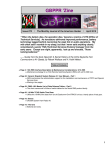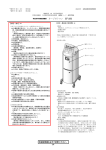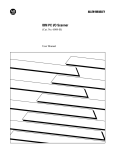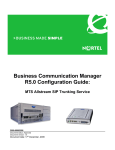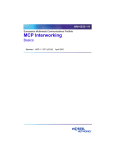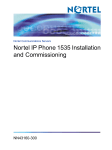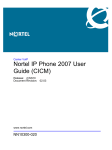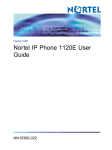Download Avaya BCM50 Reference Guide
Transcript
Business Communication Manager 50 Call Server 2000 > Solution Reference Design Guide For BCM50 to CS2K VoIP Enterprise Solution Engineering Document Date: November 4th, 2005 Document Version: 2.0 Technical Configuration Guide for: BCM50 to CS2K V2.0 November, 2005 Copyright © 2005 Nortel Networks All rights reserved. November 2005 The information in this document is subject to change without notice. The statements, configurations, technical data, and recommendations in this document are believed to be accurate and reliable, but are presented without express or implied warranty. Users must take full responsibility for their applications of any products specified in this document. The information in this document is proprietary to Nortel Networks Inc. The software described in this document is furnished under a license agreement and may be used only in accordance with the terms of that license. Trademarks Nortel, the Nortel logo, the Globemark, Unified Networks, PASSPORT and BayStack are trademarks of Nortel Networks. Adobe and Acrobat Reader are trademarks of Adobe Systems Incorporate. All other Trademarks are the property of their respective owners. ______________________________________________________________________________________________________ Nortel Networks External Distribution 1 Technical Configuration Guide for: BCM50 to CS2K V2.0 November, 2005 Abstract The proliferation of VoIP technologies and the subsequent interconnect of Nortel’s Enterprise and Carrier networks, requires the dissemination of detailed concepts and configuration information. This document describes the setup of a converged Carrier / Enterprise service consisting of PBX hosted subscribers that can leverage the wealth of services offered by the IP Telco Network. Target Audience This document is intended for an informed audience of Nortel Networks Sales Engineers, Deployment Primes, Installation personnel, and especially Customers. Acknowledgements This Configuration Guide is the product of numerous individuals and teams who have demonstrated the very best in teamwork, innovation, and integrity. The authors wish to extend their personal appreciation for their talented effort. ______________________________________________________________________________________________________ Nortel Networks External Distribution 2 Technical Configuration Guide for: BCM50 to CS2K V2.0 November, 2005 TABLE OF CONTENTS 1. INTRODUCTION ............................................................................................................................... 5 1.1 1.2 1.3 2. BCM50 TO CS2K INTERCONNECTION ........................................................................................... 5 AVAILABILITY AND ORDERING ...................................................................................................... 6 USE CASE ...................................................................................................................................... 6 CS2K SETUP ....................................................................................................................................... 7 2.1 SOFTWARE OPTIONALITY CONTROL (SOC)................................................................................... 7 2.2 TRUNKING ..................................................................................................................................... 7 2.2.1 TABLE: CLLI............................................................................................................................ 7 2.2.2 TABLE: TRKGRP ..................................................................................................................... 8 2.2.3 TABLE TRKSGRP .................................................................................................................... 8 2.2.4 TABLE TRKMEM ..................................................................................................................... 8 2.3 CALL PROCESSING (CALLP) TRANSLATIONS ................................................................................. 8 2.3.1 TABLE XLAPLAN..................................................................................................................... 9 2.3.2 TABLE OFRT ........................................................................................................................... 9 2.3.3 TABLE HNPACONT................................................................................................................. 9 2.3.4 TABLE LTDEF ......................................................................................................................... 9 2.3.5 TABLE LTDATA ..................................................................................................................... 10 2.3.6 TABLE LTCALLS ................................................................................................................... 10 2.3.7 TABLE LTMAP....................................................................................................................... 10 2.4 PACKETIZATION ........................................................................................................................... 10 2.5 ETSI PRI TRUNKS & OVERLAP SIGNALING ................................................................................. 11 2.5.1 Problem Identification ............................................................................................................ 11 2.5.2 Workaround............................................................................................................................ 12 3. BCM50................................................................................................................................................ 15 3.1 CAVEATS ..................................................................................................................................... 15 3.1.1 Centrex IP Call Manager (CICM) SN07 Testing ................................................................... 15 3.1.2 Called Party Number Display (CPND) .................................................................................. 15 3.1.3 T.38 FAX................................................................................................................................. 16 3.2 KEY CODES.................................................................................................................................. 16 3.3 IP NETWORKING .......................................................................................................................... 17 3.4 IP TELEPHONY RESOURCES ......................................................................................................... 18 3.5 TELEPHONES & LINES .................................................................................................................. 20 3.6 DIALING PLAN ............................................................................................................................. 20 3.7 H.323........................................................................................................................................... 23 4. GWC ................................................................................................................................................... 26 4.1 4.2 4.3 4.4 5. APPENDIX A: DMS READ FILES................................................................................................. 32 5.1.1 6. ADDING GWC IN CMT................................................................................................................ 26 ASSOCIATING H323 GATEWAY TO GWC IN CMT ....................................................................... 27 RESERVING H323 CARRIERS ON H323 GATEWAY IN CMT.......................................................... 29 CONFIGURING VOICE NETWORK SETTINGS ................................................................................. 30 Translation Verification (Traver) ........................................................................................... 32 APPENDIX B: DMS CLLIREF ....................................................................................................... 37 ______________________________________________________________________________________________________ Nortel Networks External Distribution 3 Technical Configuration Guide for: BCM50 to CS2K V2.0 November, 2005 List of Figures Figure 1: Succession Network Reference Architecture................................................................... 5 Figure 2: Detailed Network Diagram ............................................................................................... 6 Figure 3: H.225 Setup Packet Trace ............................................................................................. 11 Figure 4: BCM50 Key Codes......................................................................................................... 16 Figure 5: BCM50 IP Addressing .................................................................................................... 17 Figure 6: BCM50 DHCP, General Settings ................................................................................... 18 Figure 7: BCM50 Telephony Resources, IP Terminal Global Settings ......................................... 19 Figure 8: BCM50 Telephony Resources, IP Terminal Details....................................................... 19 Figure 9: BCM50 Lines, Target Lines............................................................................................ 20 Figure 10: BCM50 Telephony, Active Sets ................................................................................... 20 Figure 11: BCM50 Dialing Plan, Public Network ........................................................................... 21 Figure 12: BCM50 Dialing Plan, Private Networks........................................................................ 21 Figure 13: BCM50 Dial Plan - Routing, Routes............................................................................. 22 Figure 14: BCM50 Dial Plan - Routing, Destination Codes........................................................... 22 Figure 15: BCM50 Dialing Plan - Line Pools ................................................................................. 23 Figure 16: BCM50 Port Ranges .................................................................................................... 24 Figure 17: BCM50 Telephony Resources – IP Trunks, Local Gateway........................................ 24 Figure 18: BCM50 Telephony Resources, Media Parameters...................................................... 25 Figure 19: GWC – Add GWC ........................................................................................................ 26 Figure 20: GWC – Provisioning ..................................................................................................... 27 Figure 21: GWC – Associate Media Gateway............................................................................... 28 Figure 22: GWC – Provisioning Gateway...................................................................................... 29 Figure 23: GWC – Add Carrier ...................................................................................................... 29 Figure 24 GWC – Carriers............................................................................................................. 30 Figure 25: GWC Packet Level Main Screen.................................................................................. 31 Figure 26: Packetization Rate Selection ....................................................................................... 31 ______________________________________________________________________________________________________ Nortel Networks External Distribution 4 Technical Configuration Guide for: BCM50 to CS2K V2.0 November, 2005 1. Introduction The coupling of Nortel’ Succession Solution with the Business Communication Manager (BCM) has proven to be a significant step forward in the convergence of Enterprise and Carrier Networks. It is fully anticipated that the addition of CS2K Gatekeeper functionality will result in a new specter of service offerings, and interconnect scenarios, to the Enterprise. This guide details the setup of a field deployable solution. Figure 1: Succession Network Reference Architecture 1.1 BCM50 to CS2K Interconnection The nuts and bolts of the architecture are the workings of the IP domain that binds the BCM to the CS2K (see Figure 2: Detailed Network Diagram). This new coupling of the traditional Carrier and Enterprise environments will require that SEs and Partners have a basic understanding of the components within this hybrid topology. ______________________________________________________________________________________________________ Nortel Networks External Distribution 5 Technical Configuration Guide for: BCM50 to CS2K CS2K November, 2005 10.102.40.8 MS GWC (Gatekeeper) ENET LTC V2.0 BCM_M50 10.102.40.60 Interwork SPM 10.102.40.108 613-235-4353 10.102.40.13 IP LCME Set A i2004 10.102.40.109 Extension 353 Target Line 126 10.102.40.110 613-236-4353 Set C TDM Phone 613-234-4025 BCM2_M50 Set B i2004 10.102.40.112 Extension 353 Target Line 127 Figure 2: Detailed Network Diagram From the Enterprise, Succession’s CS2K will appear as a Gatekeeper in the IP space; and as such will require minimum programming to interoperate correctly. However, the challenge for SEs will rest with the design, implementation, and understanding of the carrier portion of the network. The CS2K will view the BCM as a call processing destination, defined in terms of Directory Numbers (DN), virtual trunks, and gateway endpoints. Detailed examples of these entities are available in the following chapters of this document. 1.2 Availability and Ordering This solution applies to the following Generally Available (GA) software streams: • • BCM50 Release 1 SN07, ISN07, SN08, and ISN08 1.3 Use Case Within this document, a simple office-code translation plan will be used as a reference framework. From Figure 2: Detailed Network Diagram, the BCM50s are accessed via an area code of 550; a VoIP Trunk access code of 9 will be used on the BCMs. From the above diagram, here are a few examples of dialing sequences: • A (BCM_M50) calls B (BCM2_M50) via the CS2K, A dials: 9-550-236-4353 • B (BCM2_M50) call A (BCM_M50) via the CS2K, B dials: 9-550-235-4353 • A calls C (CS2K analogue line), A dials: 9-234-4025 • C calls B (BCM2_M50), C dials: 550-235-4353 ______________________________________________________________________________________________________ Nortel Networks External Distribution 6 Technical Configuration Guide for: BCM50 to CS2K V2.0 November, 2005 2. CS2K Setup It should be clearly understood by the reader that the design and implementation of translations is customer specific. What is contained herein is one way of accomplishing the objective; there are other methods which are equally effective. To simplify the vulgarization of the concepts within, a North American ISDN PRI context was selected. This does not limit this solution to that signaling context; it does work with other PRI variants. 2.1 Software Optionality Control (SOC) It is critical that the CS2K have the H.323 Gatekeeper functionality activated. For further information on the SOC, please consult NTP 297-8991-901 (www.nortel.com); customers may purchase software activation codes from authorized Nortel Sales Representatives. For the H.323 Gatekeeper, please ensure that CS2B0004 is enabled. Firstly, you need to unlock the SOC by assigning a limit; this will also set the right to use flag: • assign limit 100 <license key #1> to CS2B0004 Secondly, activation is accomplished by setting the state. This requires a second license key: • assign state on <license key #2> to CS2B0004 When completed, the CS2B004 option should appear as follows: >soc SOC: OPTION NAME RTU STATE USAGE LIMIT UNITS LAST_CHG CS2B0004 H323 Gatekeeper Y ON 8 100 1VC 05/01/20 2.2 Trunking The CS2K needs to have unique addressable connection paths on which it may route calls to each BCM. These are referred to as trunk members within a group. They are defined in the following order through the tables. 2.2.1 TABLE: CLLI The Common Language Location Identifier, or CLLI, is the route of the trunk group datafill. In this example, the CLLI BCM_M50 is associated to an administrator. CLLI ADNUM TRKGRSIZ ADMININF ---------------------------BCM_M50 411 50 PIERRE_FOURNIER ______________________________________________________________________________________________________ Nortel Networks External Distribution 7 Technical Configuration Guide for: BCM50 to CS2K V2.0 November, 2005 2.2.2 TABLE: TRKGRP The trunk group is characterized with PRA to indicate that it will appear to call processing as ISDN PRI signaling and ISDN translations. GRPKEY GRPTYP TRAFSNO PADGRP NCCLS GRPINFO -----------------------------------------BCM_M50 PRA 0 NPDGP NCRT MIDL N (ISDN 550) $ $ 2.2.3 TABLE TRKSGRP Detailed signaling setup (DS1, Q.931) and physical location (GWC card & port) are defined here. SGRPKEY CARDCODE SGRPVAR SGRPVAR -------------------------------BCM_M50 0 DS1SIG ISDN 20 20 87Q931 2 N STAND NETWORK PT_PT USER N UNEQ 160 N DEFAULT GWC 9 114 1 64K HDLC $ $ 2.2.4 TABLE TRKMEM CLLI EXTRKNM SGRP MEMVAR -----------------------BCM_M50 1 0 GWC 9 114 2 BCM_M50 2 0 GWC 9 114 3 BCM_M50 3 0 GWC 9 114 4 BCM_M50 4 0 GWC 9 114 5 2.3 Call Processing (CallP) Translations Designing CallP translations requires training and experience. The text of this section provides enough information to permit qualified personnel to complete the task. It is not a replacement for adequate training; please do not attempt unless properly qualified to do so. The trunk group has been defined as an ISDN PRI, so the next step is to define a set of rudimentary translations to be able to route the calls to and from the BCM. For this, • • • • a “type” of translation is defined in XLAPLAN an office route in table OFRT association between the dialed digits and the office routes in HNPACONT and its sub tables and finally, the ISDN specifics in “LT” family (ISDN Logical Terminal) of tables ______________________________________________________________________________________________________ Nortel Networks External Distribution 8 Technical Configuration Guide for: BCM50 to CS2K V2.0 November, 2005 2.3.1 TABLE XLAPLAN XLAPIDX SCRNCL HSTS PRTNM ZEROMPOS RESINF OPTIONS ADMININF ---------------------------------------------------------BCM_PRI_TRAF NSCR 550 PRI_TRAF NONE N $ PRI_TRAFFIC 2.3.2 TABLE OFRT RTE RTELIST OPTIONS ------------------550 (N D BCM_M50 0 N N) $ $ 2.3.3 TABLE HNPACONT STS SNPA NORTREFS NOAMBIGC RTEREF HNPACODE ATTRIB RTEMAP OPTIONS ---------------------------------------------------------------613 Y 1023 0 (237) (1) (0) (0) $ 2.3.3.1 SUB RTEREF RTE RTELIST ----------55 (T OFRT 550) $ RET 613 Y 1023 0 (237) (1) (0) (0) $ 2.3.3.2 SUB HNPACODE FROMDIGS TODIGS CDRRTMT ----------------------235 235 LRTE 55 RET 613 Y 1023 0 (237) (1) (0) (0) $ 2.3.4 TABLE LTDEF Is the Logical Terminal (LT) definition table; it defines logical terminals and access privileges. It also specifies an LTID and access privileges for the PRI trunk group. LTKEY LTAP CLASSREF ------------------______________________________________________________________________________________________________ Nortel Networks External Distribution 9 Technical Configuration Guide for: BCM50 to CS2K V2.0 November, 2005 ISDN 550 B PRA 47 NTNAPRI V1 NIL (NOPMD ) $ 2.3.5 TABLE LTDATA The logical terminal data table stores service-related data associated with the logical terminal identifier (LTID), field LTDKEY, which is the key to this table. LTDKEY LTDRSLT -------------ISDN 550 SERV SERV Y Y ALWAYS ALWAYS (PRI_IP_PROT H323) $ 2.3.6 TABLE LTCALLS Logical terminal calls table. It specifies the types of calls that can route over each PRI trunk group. This table defines the first translations for each trunk group and call type. LTID XLARTSEL OPTIONS --------------------ISDN 550 PUB XLALEC 0 BCM_PRI_TRAF NLCA_NILLA_0 $ 2.3.7 TABLE LTMAP The logical terminal map table associates the logical terminal identifier (LTID) to a trunk group (identified by CLLI). LTKEY MAPPING OPTION -------------------ISDN 550 CLLI BCM_M50 (TEI 0) $ 2.4 Packetization Succession CS2K Solution supports both 10 and 20 millisecond (ms) rates; what is critical is that all components bet set to the same value. Care must be taken to ensure that the IW-SPM and the GWC are set to the same rate as the CS2K and the BCM. The IW-SPM, required for interwork with locally hosted legacy lines, is set as follows for 20 ms: TABLE MNIPPARM TOP MNKEY DFCODEC PRFCODEC PKTRATE INGRESS EGRESS JITMIN JITMAX JITTARG ECAN VOICE CMFNOISE T38 RFC2833 RTCP TONESET LOGINT CRCERROR USIZEPKT OSIZEPKT FRAGMENT JABBER DROPEVNT BRDCAST JITTER LATENCY VPKTLOST MINLOG OMPARMS ------------------------------------------------------------------------IWSPM G711ULAW G729 20 0 0 0 100 0 DISABLE OFF DISABLE DISABLE DISABLE N NORTHAMERICA 5 20 10 20 10 20 10 20 10 20 10 20 10 20 10 20 10 20 10 20 10 1000 50 1000 1000 ______________________________________________________________________________________________________ Nortel Networks External Distribution 10 Technical Configuration Guide for: BCM50 to CS2K V2.0 November, 2005 Please see 4.4 Configuring Voice Network Settings for information on the GWC packetization setup. 2.5 ETSI PRI Trunks & Overlap Signaling There are two types of signaling associated with ISDN PRI: ENBLOC and OVERLAP. Both pertain to the method in which digits are forwarded, first refers to the method when all digits are sent at one time and the latter where they are forwarded in multiple messages. Unused in North America, overlap is quite common in the remainder of the world. There are a few key points that should be highlighted to ensure simple operation of a BCM connected to an overlap aware network: • In general BCMs, who do not support overlap signaling, can interoperate with PRI overlap signaling provided all digits are contained within the H.323 setup message. • Future CS2K releases intend to incorporate PRI variant checking to ensure that H.323 trunk groups destined to BCMs will not support overlap signaling. 2.5.1 Problem Identification The BCM will reject H.225 setup messages that contain the “canOverlapSend” flag set to “True”, see highlight box inError! Reference source not found. Figure 3: H.225 Setup Packet Trace ______________________________________________________________________________________________________ Nortel Networks External Distribution 11 Technical Configuration Guide for: BCM50 to CS2K V2.0 November, 2005 2.5.2 Workaround Setting the Q.931 “sending complete” flag will allow the BCM to ignore the canOverlapSend value and accept the incoming H.225 setup message. The CS2K’s call processing translations can do this on a per trunk basis; this is accomplished in table PXCODE. 2.5.2.1 Identifying the Correct Entry in Table PXCODE A quick way to identify the target tuple is to execute a traver. You will need 2 pieces of information: a valid DN on the CS2K, and the trunk access code for the BCM. For this example, we are using DN 820-2524 with a trunk access code of 323. Note that the destination digits used, i.e. 1234567, are simply padding. The relevant data is highlighted in yellow: traver l 8202524 3231234567 b TABLE IBNLINES LG 00 0 00 31 0 DT STN IBN 8202524 CSLINES 0 0 115 $ TABLE DNATTRS TUPLE NOT FOUND TABLE DNGRPS TUPLE NOT FOUND TABLE IBNFEAT TUPLE NOT FOUND TABLE CUSTSTN TUPLE NOT FOUND TABLE OFCVAR AIN_OFFICE_TRIGGRP NIL INAP Origination Attempt TDP: no subscribed trigger. INAP Info Collected TDP: no subscribed trigger. TABLE NCOS CSLINES 0 0 0 DFLT $ TABLE CUSTHEAD: CUSTGRP, PRELIMXLA, CUSTXLA, FEATXLA, VACTRMT, AND DIGCOL CSLINES NXLA K4PSTN CSFETXLA 0 CSACCDIG TABLE DIGCOL CSACCDIG 3 COL L 7 TABLE IBNXLA: XLANAME K4PSTN TUPLE NOT FOUND Default from table XLANAME: K4PSTN (NET N N 0 N CSDIG N Y DOD N K4PSTN CS_NPRT CS_NIL NONE $) $ F TABLE DIGCOL CSDIG 3 COL L 7 TABLE LINEATTR K4PSTN IBN NONE NT 0 0 NILSFC 0 PX K4PSTN NIL 00 CS_NPRT CS_NIL $ LCABILL OFF - BILLING DONE ON BASIS OF CALLTYPE TABLE XLAPLAN CS_NPRT NSCR 115 NPRT NONE N $ $ TABLE RATEAREA CS_NIL NLCA NIL NILLATA $ TABLE PXHEAD K4PSTN DFLT CONT ( MM 7 7) ( XLT PX K4PSTN)$ DFOP ( CLASS INTL) ( AMAXLAID PSTN)$ NOCON STD THE DIGITS USED TO INDEX THE NEXT TABLE ARE: 3231234567 TABLE PXCODE ______________________________________________________________________________________________________ Nortel Networks External Distribution 12 Technical Configuration Guide for: BCM50 to CS2K V2.0 November, 2005 K4PSTN 323 323 RTE ( PF 3) ( MM 5 18) ( DEST 115)$ TABLE: PXRTE KEY: K4PSTN 115 . S OTT5BCM EXIT TABLE PXRTE TABLE AMAXLAID PSTN DFLT (FLEXCTYP GENERIC 900 OVRDALL )$ INAP Info Analyzed TDP: no subscribed trigger. INAP Route Select Failure TDP: no subscribed trigger. +++ TRAVER: SUCCESSFUL CALL TRACE +++ DIGIT TRANSLATION ROUTES 1 OTT5BCM N CDN E164 IN 1234567 NIL_NSF BC SPEECH TREATMENT ROUTES. TREATMENT IS: GNCT 1 BUSYANN +++ TRAVER: SUCCESSFUL CALL TRACE +++ From this we see that the PXCODE entry is K4PSTN 323 323, and that the current minimum digits is 5 with a maximum of 18. We will need to reset these values to 7 and 7; as we are using 7 digit dialing to the BCM. 2.5.2.2 Table PXCODE The following is a session capture of the required change; it is self explanatory. >TABLE PXCODE; pos K4PSTN 323 323 JOURNAL FILE UNAVAILABLE - DMOS NOT ALLOWED TABLE: PXCODE K4PSTN 323 323 RTE (PF 3) (MM 5 18) (DEST 115) $ >cha JOURNAL FILE UNAVAILABLE - DMOS NOT ALLOWED ENTER Y TO CONTINUE PROCESSING OR N TO QUIT >y XLASEL: RTE > OSEL: PF > PFDIGS: 3 > OSEL: MM > MIN: 5 >7 MAX: 18 >7 OSEL: DEST > ______________________________________________________________________________________________________ Nortel Networks External Distribution 13 Technical Configuration Guide for: BCM50 to CS2K V2.0 November, 2005 DEST: 115 > OSEL: >$ TUPLE TO BE CHANGED: K4PSTN 323 323 RTE (PF 3) (MM 7 7) (DEST 115) $ ENTER Y TO CONFIRM, N TO REJECT OR E TO EDIT. >y TUPLE CHANGED JOURNAL FILE INACTIVE >list XLANAME FROMD TOD XLADATA ---------------------------------------------------------------------------K4PSTN 323 323 RTE (PF 3) (MM 7 7) (DEST 115) $ ______________________________________________________________________________________________________ Nortel Networks External Distribution 14 Technical Configuration Guide for: BCM50 to CS2K V2.0 November, 2005 3. BCM50 The BCM50 is programmed via a new application, the Element Manager, available via HTTP access to the maintenance port. A good number of screen captures of this new Element Manager have been included in this document in order to familiarize users with both the location and the format of the programming information. 3.1 Caveats 3.1.1 Centrex IP Call Manager (CICM) SN07 Testing The specific combination of BCM50 to CICM VoIP lines in the SN08 context was successfully tested. An SN07 CICM setup was not available at the time of test, and was not explicitly verified. However, it is expected that there will be no operational differences between the SN08 and SN07 versions. 3.1.2 Called Party Number Display (CPND) 3.1.2.1 Network Name Display Business Communications Manager displays the name of the calling party, when available, on both Private and Public ISDN PRI interfaces. The displayed name can include the Receiving Calling Name, Receiving Redirected Name, and/or Receiving Connected Name. If only a number is available for CLI on an incoming call, you can program a system speed dial in such a way that a name displays when that number calls in. The outgoing name display consists of the Business name and the telephone name. The following table provides a list of the name/number display features and the list of ISDN interfaces that support each feature. Interface Feature NI PRI DMS Custom PRI SL1 (MCDN) NI-BRI ETSI EURO Receiving Calling Name Supported Supported Supported Supported Receiving Redirected Name Supported Supported Supported Receiving Connected Name Supported Supported Sending Calling Party Name Supported Supported Supported Connected Name Supported Supported Supported ETSI QSIG Supported Supported Supported Supported Supported Table 1: CPND Test Results Note: Network Name Display is an optional feature that is available based on the interface you subscribe to. MCDN note: MCDN networks fully support name display features. 3.1.2.2 Receiving and Sending Calling Party Name Network Name Display allows the name of an incoming PRI/BRI, analog with CLID, or VoIP with MCDN call to appear on the Business Communications Manager telephone receiving the call. Calling Party Name with status of Private can appear on the Called Party telephone as Private name. If the incoming Calling Name is defined by the CO as a private name, then Private name appears on the answering telephone. If the Calling Party Name is unavailable it can appear on ______________________________________________________________________________________________________ Nortel Networks External Distribution 15 Technical Configuration Guide for: BCM50 to CS2K V2.0 November, 2005 the Called Party telephone as Unknown name. If the call is answered by a Hunt group, the hunt group name appears instead of the telephone name in forming the connected name. The Connected Name is a transient display that appears for approximately three seconds. The Connected Name is sent only if the OLI is programmed (“Configuring line access” on page 405). You can program both a public and private OLI. The system uses the one appropriate to the type of call. 3.1.2.3 Network name display interactions If available, the Calling and Connected Name information passes between trunks with Selective Line Redirection (SLR). Only Calling Name information passes between trunks in cases where Direct System Inward Access (DISA) results in tandeming of trunks. 3.1.3 T.38 FAX T.38 FAX support is enabled via the selection of the BCM profile in the GWC. Supported functionality and detailed configuration information for the CS2K, GWC, and the BCM can be found on www.nortel.com . 3.2 Key Codes Ensure that the system has an appropriate number of the following key coded functionality: • • IP Client seats VoIP GW Trunks Figure 4: BCM50 Key Codes ______________________________________________________________________________________________________ Nortel Networks External Distribution 16 Technical Configuration Guide for: BCM50 to CS2K V2.0 November, 2005 3.3 IP Networking The BCMs in this example are configured as per Figure 2: Detailed Network Diagram on page 5. If DHCP is used for the IP Sets, it needs to be activated and a range of IPs need to be setup via the Address Range Tab (Figure 6: BCM50 DHCP, General Settings). Note: in order to simplify the setup, BCM50 NAT is not used. Figure 5: BCM50 IP Addressing ______________________________________________________________________________________________________ Nortel Networks External Distribution 17 Technical Configuration Guide for: BCM50 to CS2K V2.0 November, 2005 Figure 6: BCM50 DHCP, General Settings 3.4 IP Telephony Resources The IP Telephony resources are listed in the Telephony Resources level of the Resources level. It is at this point where the default CODEC and packetization (payload size) are configured. In section 2.4 Packetization, the reader is reminded that Succession supports both 10 and 20 mS sampling rates, and the selected value must be consistently applied to both the IW-SPM and the GWC. The selected value must also be used in the BCM50. Note that the IP and Application Sets module must be highlighted (clicked upon) in order to see the details. ______________________________________________________________________________________________________ Nortel Networks External Distribution 18 Technical Configuration Guide for: BCM50 to CS2K V2.0 November, 2005 Figure 7: BCM50 Telephony Resources, IP Terminal Global Settings Any active IP sets will be displayed in the IP Terminal. Figure 8: BCM50 Telephony Resources, IP Terminal Details ______________________________________________________________________________________________________ Nortel Networks External Distribution 19 Technical Configuration Guide for: BCM50 to CS2K V2.0 November, 2005 3.5 Telephones & Lines Start with the selection of a target line. Program both the Public and Private received digits. Figure 9: BCM50 Lines, Target Lines The target line is assigned to the Set at the Active Sets level. In addition the Public and Private Outgoing Line Identification (OLI) can to be programmed here. Figure 10: BCM50 Telephony, Active Sets 3.6 Dialing Plan A few key settings are captured in the following screen shots: • • Public received number length: 7 digits (CS2K pushes 613-234-4353) Public network dialing plan: National ______________________________________________________________________________________________________ Nortel Networks External Distribution 20 Technical Configuration Guide for: BCM50 to CS2K V2.0 November, 2005 Figure 11: BCM50 Dialing Plan, Public Network Note: No changes were made to the Private Network settings. Pictured here are the defaults used. Figure 12: BCM50 Dialing Plan, Private Networks A new route, number 100, was created and assigned to BlocA the VoIP pooled resources. Note that the external number, digits that can be inserted as a prefix, was intentionally left blank. ______________________________________________________________________________________________________ Nortel Networks External Distribution 21 Technical Configuration Guide for: BCM50 to CS2K V2.0 November, 2005 Figure 13: BCM50 Dial Plan - Routing, Routes It was simpler if the access code of 9 was to be used to access an outgoing line form the BCM50. Thus, destination code 9 was mapped to route 100, with an absorbed length of all (digit 9 is not passed to the CS2K). Figure 14: BCM50 Dial Plan - Routing, Destination Codes As a final check, the linepool to DN assignment is verified. Here, DN 353 does have access to BlocA. ______________________________________________________________________________________________________ Nortel Networks External Distribution 22 Technical Configuration Guide for: BCM50 to CS2K V2.0 November, 2005 Figure 15: BCM50 Dialing Plan - Line Pools 3.7 H.323 Key points for this part of the setup are: • • RTP and UDP Ports Ranges were left to the default settings Verify that the call signaling port is set to 1720 and the RAS to 1719. The RAS setting must match the GWC value (see Figure 21: GWC – Associate Media Gateway)1 1 This follows the common convention for Call Signaling and RAS port settings. Note that for BCM 3.x on the BCM200/400/1000, port 1719 is used for the internal gatekeeper associated with support for Symbol NetVision phones and cannot be used for CS2K RAS. See Nortel technical configuration ITAS TIP 317 GL, January 2005, for additional details on selecting an appropriate RAS port for BCM 3.x systems. ______________________________________________________________________________________________________ Nortel Networks External Distribution 23 Technical Configuration Guide for: BCM50 to CS2K V2.0 November, 2005 Figure 16: BCM50 Port Ranges The details of the CS2K are added at the Telephony Resource, IP Trunks level: • H.323 Call signaling: Gatekeeper Routed • Primary Gatekeeper IP: the GWC’s IP • Alias Name: must match value in GWC (Figure 21: GWC – Associate Media Gateway) • Gateway Protocol: none Figure 17: BCM50 Telephony Resources – IP Trunks, Local Gateway Click on the Media Parameters tab, and verify/set the values for • Preferred CODEC list: ensure G.711 and G.729 are included • Set the default sample sizes to either 10 or 20 mS and remember to set matching values on IW-SPM and GWC. ______________________________________________________________________________________________________ Nortel Networks External Distribution 24 Technical Configuration Guide for: BCM50 to CS2K V2.0 November, 2005 Figure 18: BCM50 Telephony Resources, Media Parameters ______________________________________________________________________________________________________ Nortel Networks External Distribution 25 Technical Configuration Guide for: BCM50 to CS2K V2.0 November, 2005 4. GWC The Gateway Controller (GWC) is managed via the CS2K Management Tool (CMT): Sun workstation hosted Nortel OAM application. The following setup will be executed by the hosting Telco and not in the domain of the Enterprise. The configuration steps are self-explanatory; additional comments have been added to highlight key input. For further information, please refer to NN10205-511 version 05.02 Gateway Controller Configuration Management located on http://nortel.com/helmsman online repository for Packet Trunking - IP SN07 Standard (PTIP07). 4.1 Adding GWC in CMT Follow pages 99-106 of the NTP NN10205-511. This section lists all the required information to add a GWC in CMT. Figure 19: GWC – Add GWC ______________________________________________________________________________________________________ Nortel Networks External Distribution 26 Technical Configuration Guide for: BCM50 to CS2K V2.0 November, 2005 Figure 20: GWC – Provisioning 4.2 Associating H323 Gateway to GWC in CMT Following the procedures documented in pages 147-156 of the NTP NN10205-511, a H323 Gateway is associated to a GWC in the following manner: ______________________________________________________________________________________________________ Nortel Networks External Distribution 27 Technical Configuration Guide for: BCM50 to CS2K V2.0 November, 2005 Figure 21: GWC – Associate Media Gateway ______________________________________________________________________________________________________ Nortel Networks External Distribution 28 Technical Configuration Guide for: BCM50 to CS2K V2.0 November, 2005 Figure 22: GWC – Provisioning Gateway 4.3 Reserving H323 Carriers on H323 Gateway in CMT Once the Gateway is associated to the GWC, the next step is to set up the H.323 carriers. Refer to pages 169-191 of the NTP NN10205-511. Figure 23: GWC – Add Carrier ______________________________________________________________________________________________________ Nortel Networks External Distribution 29 Technical Configuration Guide for: BCM50 to CS2K V2.0 November, 2005 Figure 24 GWC – Carriers 4.4 Configuring Voice Network Settings The final step in configuring the GWC is to ensure that sampling rate is correctly configured. Succession’s CS2K supports 10 or 20 millisecond (mS) sampling; the IW-SPM the GWC and the BCM50 need to be set to the same value. Details on the IW-SPM setup can be found in 1 ; the GWC details follow pages 20-27 of the NTP NN10205-511. ______________________________________________________________________________________________________ Nortel Networks External Distribution 30 Technical Configuration Guide for: BCM50 to CS2K V2.0 November, 2005 Figure 25: GWC Packet Level Main Screen Figure 26: Packetization Rate Selection ______________________________________________________________________________________________________ Nortel Networks External Distribution 31 Technical Configuration Guide for: BCM50 to CS2K V2.0 November, 2005 5. Appendix A: DMS Read Files 5.1.1 Translation Verification (Traver) The traver tool runs through the CS2K translations in the same order as the call processing software. Thus, by reviewing the attached travered calls, the reader can get a feel for the method by which the calls to and from the BCM are routed. 5.1.1.1 Debug Note It is highly recommended that all call debugging be executed while closely observing the DMS logs; as a successful Traver does not necessarily indicate that calls are completing. 5.1.1.2 CS2K DN to BCM Line to line call: CS2K DN 234-4025 to BCM2_M50 236-4353. Traver l 2344025 2364353 b TABLE IBNLINES HOST 00 0 00 12 0 DT STN IBN 2344025 EO613 0 0 613 $ TABLE DNATTRS TUPLE NOT FOUND TABLE DNGRPS TUPLE NOT FOUND TABLE IBNFEAT TUPLE NOT FOUND TABLE CUSTSTN EO613 AIN AIN TIID TABLE OFCVAR AIN_OFFICE_TRIGGRP TIID AIN Orig Attempt TDP: no subscribed trigger. TABLE NCOS EO613 0 0 0 EO613 ( XLAS EO613XLA EO613FT NDGT) ( ERWT )$ TABLE CUSTHEAD: CUSTGRP, PRELIMXLA, CUSTXLA, FEATXLA, VACTRMT, AND DIGCOL EO613 NXLA EO613XLA EO613FT 0 NDGT TABLE DIGCOL NDGT specified: digits collected individually TABLE IBNXLA: XLANAME EO613XLA TUPLE NOT FOUND Default from table XLANAME: EO613XLA (NET N N 0 N POTS N N GEN ( LATTR 3 613_OTTPUB_3 EA613_1) (EA NILC Y 0) $ $)$ 9 TABLE DIGCOL POTS specified: POTS digit collection TABLE LINEATTR 3 1FR NONE NT 3 0 NILSFC 0 NIL NIL 00 613_OTTPUB_3 EA613_1 $ LCABILL OFF - BILLING DONE ON BASIS OF CALLTYPE TABLE XLAPLAN 613_OTTPUB_3 NSCR 613 OTTPUB NONE Y EO613 0 0 $ $ TABLE RATEAREA EA613_1 NLCA NIL EA613 $ TABLE STDPRTCT OTTPUB ( 1) ( 0) 4 . SUBTABLE STDPRT . KEY NOT FOUND ______________________________________________________________________________________________________ Nortel Networks External Distribution 32 Technical Configuration Guide for: BCM50 to CS2K V2.0 November, 2005 . DEFAULT VALUE IS: N NP 0 NA . SUBTABLE AMAPRT . KEY NOT FOUND . DEFAULT VALUE IS: NONE OVRNONE N TABLE HPCPATTN TUPLE NOT FOUND TABLE HNPACONT 613 Y 1023 0 ( 237) ( 1) ( 0) ( 0) 0 $ . SUBTABLE HNPACODE . 236 236 LRTE 56 . SUBTABLE RTEREF . 56 T OFRT 551 . . TABLE OFRT . . 551 N D BCM2_M50 0 N N . . EXIT TABLE OFRT . EXIT TABLE RTEREF EXIT TABLE HNPACONT LNP Info: Called DN is not resident. LNP Info: HNPA results are used. AIN Info Collected TDP: no subscribed trigger. TABLE FNPA7DIG EMPTY TABLE: TUPLE NOT FOUND Checking AIN SDS Trigger Items as SDS is compatible with current call AIN Info Analyzed TDP: trigger criteria not met. +++ TRAVER: SUCCESSFUL CALL TRACE +++ DIGIT TRANSLATION ROUTES 1 BCM2_M50 SPEECH TREATMENT ROUTES. 1 VCA N CDN E164 L 2364353 NIL_NSF BC TREATMENT IS: GNCT +++ TRAVER: SUCCESSFUL CALL TRACE +++ 5.1.1.3 BCM Trunk to CS2K DN Incoming to the CS2K from the BCM2_M50’s trunk to the CS2K DN 234-4025. traver tr BCM2_M50 2344025 b TABLE TRKGRP BCM2_M50 PRA 0 NPDGP NCRT MIDL N (ISDN 551) $ $ TABLE LTCALLS ISDN 551 PUB XLALEC 0 BCM_PRI_TRAF NLCA_NILLA_0 $ TABLE CUSTSTN TUPLE NOT FOUND TABLE OFCVAR AIN_OFFICE_TRIGGRP TIID TABLE LINEATTR 0 IBN NONE NT 0 0 NILSFC 0 NIL NIL 00 613_NPRT_0 NLCA_NILLA_0 $ LCABILL OFF - BILLING DONE ON BASIS OF CALLTYPE ______________________________________________________________________________________________________ Nortel Networks External Distribution 33 Technical Configuration Guide for: BCM50 to CS2K V2.0 November, 2005 TABLE XLAPLAN BCM_PRI_TRAF NSCR 550 PRI_TRAF NONE N $ PRI_TRAFFIC TABLE RATEAREA NLCA_NILLA_0 NLCA NIL NILLATA $ TABLE STDPRTCT PRI_TRAF ( 0) ( 0) 5 . SUBTABLE STDPRT WARNING: CHANGES IN TABLE STDPRT MAY ALTER OFFICE BILLING. CALL TYPE DEFAULT IS NP. PLEASE REFER TO DOCUMENTATION. . KEY NOT FOUND . DEFAULT VALUE IS: N NP 0 NA . SUBTABLE AMAPRT . KEY NOT FOUND . DEFAULT VALUE IS: NONE OVRNONE N TABLE HPCPATTN TUPLE NOT FOUND TABLE HNPACONT 550 Y 700 0 ( 2) ( 1) ( 0) ( 0) 3 $ . SUBTABLE HNPACODE . 234 234 DN 613 234 TABLE TOFCNAME 613 234 $ TABLE DNINV 613 234 4025 L HOST 00 0 00 12 TABLE DNFEAT TUPLE NOT FOUND TABLE DNATTRS TUPLE NOT FOUND TABLE DNGRPS TUPLE NOT FOUND LNP Info: Called DN is resident. LNP Info: Called DN has native NPANXX. LNP Info: HNPA results are used. AIN Info Collected TDP: no subscribed trigger. Checking AIN SDS Trigger Items as SDS is compatible with current call AIN Info Analyzed TDP: trigger criteria not met. AIN Term Attempt TDP: no subscribed trigger. +++ TRAVER: SUCCESSFUL CALL TRACE +++ DIGIT TRANSLATION ROUTES 1 LINE TREATMENT ROUTES. 1 VCA 6132344025 ST TREATMENT IS: GNCT +++ TRAVER: SUCCESSFUL CALL TRACE +++ 5.1.1.4 Inter-BCM Call The first leg of the call originates as a trunk (BCM2_M50) which is first dialing the office code of 550, then BCM_M50’s DN 235-4353. ______________________________________________________________________________________________________ Nortel Networks External Distribution 34 Technical Configuration Guide for: BCM50 to CS2K V2.0 November, 2005 >traver tr bcm2_m50 5502354353 b TABLE TRKGRP BCM2_M50 PRA 0 NPDGP NCRT MIDL N (ISDN 551) $ $ TABLE LTCALLS ISDN 551 PUB XLALEC 0 BCM_PRI_TRAF NLCA_NILLA_0 $ TABLE CUSTSTN TUPLE NOT FOUND TABLE OFCVAR AIN_OFFICE_TRIGGRP TIID TABLE LINEATTR 0 IBN NONE NT 0 0 NILSFC 0 NIL NIL 00 613_NPRT_0 NLCA_NILLA_0 $ LCABILL OFF - BILLING DONE ON BASIS OF CALLTYPE TABLE XLAPLAN BCM_PRI_TRAF NSCR 550 PRI_TRAF NONE N $ PRI_TRAFFIC TABLE RATEAREA NLCA_NILLA_0 NLCA NIL NILLATA $ TABLE STDPRTCT PRI_TRAF ( 0) ( 0) 5 . SUBTABLE STDPRT WARNING: CHANGES IN TABLE STDPRT MAY ALTER OFFICE BILLING. CALL TYPE DEFAULT IS NP. PLEASE REFER TO DOCUMENTATION. . KEY NOT FOUND . DEFAULT VALUE IS: N NP 0 NA . SUBTABLE AMAPRT . KEY NOT FOUND . DEFAULT VALUE IS: NONE OVRNONE N TABLE HPCPATTN TUPLE NOT FOUND TABLE HNPACONT 550 Y 700 0 ( 2) ( 1) ( 0) ( 0) 3 $ . SUBTABLE HNPACODE . 550235 550235 FRTE 550 . SUBTABLE RTEREF . 550 T OFRT 550 . . TABLE OFRT . . 550 N D BCM_M50 0 N N . . EXIT TABLE OFRT . EXIT TABLE RTEREF EXIT TABLE HNPACONT LNP Info: Called DN is not resident. LNP Info: HNPA results are used. AIN Info Collected TDP: no subscribed trigger. Checking AIN SDS Trigger Items as SDS is compatible with current call AIN Info Analyzed TDP: trigger criteria not met. +++ TRAVER: SUCCESSFUL CALL TRACE +++ DIGIT TRANSLATION ROUTES 1 BCM_M50 SPEECH TREATMENT ROUTES. N CDN E164 NA 5502354353 NIL_NSF BC TREATMENT IS: GNCT ______________________________________________________________________________________________________ Nortel Networks External Distribution 35 Technical Configuration Guide for: BCM50 to CS2K V2.0 November, 2005 1 VCA +++ TRAVER: SUCCESSFUL CALL TRACE +++ ______________________________________________________________________________________________________ Nortel Networks External Distribution 36 Technical Configuration Guide for: BCM50 to CS2K V2.0 November, 2005 6. Appendix B: DMS CLLIREF The CLLIREF tool scans all CS2K tables for instances of a specific CLLI. The output of the BCM_M50 CLLIREF is included to ensure that no tables were omitted from this document. >clliref search BCM_M50 CLLI "BCM_M50" occurs in the following tuples: Table Key: Sub Tuple -------- -------> ------------------------------------------------------CLLI BCM_M50 411 50 PIERRE_FOURNIER TRKGRP BCM_M50 PRA 0 NPDGP NCRT MIDL N (ISDN 550) $ $ CLLIMTCE BCM_M50 BCM_M5 5 10 15 NSS 0 0 N N (4) OFRT 550 (N D BCM_M50 0 N N) $ $ TRKSGRP BCM_M50 0 DS1SIG ISDN 20 20 87Q931 2 N STAND NETWORK PT_PT USER N UNEQ 160 N DEFAULT GWC 9 114 1 64K HDLC $ $ TRKMEM BCM_M50 1 0 GWC 9 114 2 TRKMEM BCM_M50 2 0 GWC 9 114 3 TRKMEM BCM_M50 3 0 GWC 9 114 4 TRKMEM BCM_M50 4 0 GWC 9 114 5 TRKNAME 411 BCM_M50 LTMAP ISDN 550 CLLI BCM_M50 (TEI 0) $ ===================== Total of 11 >clliref search BCM2_M50 CLLI "BCM2_M50" occurs in the following tuples: Table Key: Sub Tuple -------- -------> ------------------------------------------------------CLLI BCM2_M50 413 50 PIERRE_FOURNIER TRKGRP BCM2_M50 PRA 0 NPDGP NCRT MIDL N (ISDN 551) $ $ CLLIMTCE BCM2_M50 BCM2_M 5 10 15 NSS 0 0 N N (4) OFRT 551 (N D BCM2_M50 0 N N) $ $ TRKSGRP BCM2_M50 0 DS1SIG ISDN 20 20 87Q931 2 N STAND NETWORK PT_PT USER N UNEQ 160 N DEFAULT GWC 9 114 49 64K HDLC $ $ TRKMEM BCM2_M50 1 0 GWC 9 114 50 TRKMEM BCM2_M50 2 0 GWC 9 114 51 TRKMEM BCM2_M50 3 0 GWC 9 114 52 TRKMEM BCM2_M50 4 0 GWC 9 114 53 TRKNAME 413 BCM2_M50 LTMAP ISDN 551 CLLI BCM2_M50 (TEI 0) $ ===================== Total of 11 Occurrences of BCM2_M50 ______________________________________________________________________________________________________ Nortel Networks External Distribution 37 Technical Configuration Guide for: BCM50 to CS2K V2.0 November, 2005 Contact Us: For product support and sales information, visit the Nortel Networks website at: http://www.nortel.com In North America, dial toll-free 1-800-4Nortel, outside North America dial 987-288-3700. ______________________________________________________________________________________________________ Nortel Networks External Distribution 38 Technical Configuration Guide for: BCM50 to CS2K V2.0 November, 2005 ______________________________________________________________________________________________________ Nortel Networks External Distribution 39








































